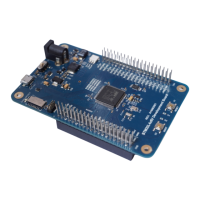DocID024597 Rev 3 1501/1693
RM0351 USB on-the-go full-speed (OTG_FS)
1644
The HNP program model is described in detail in Section 43.16: OTG_FS programming
model.
43.5.3 SRP dual role device
The SRP capable bit in the global USB configuration register (SRPCAP bit in
OTG_GUSBCFG) enables the OTG_FS core to switch off the generation of V
BUS
for the A-
device to save power. Note that the A-device is always in charge of driving V
BUS
regardless
of the host or peripheral role of the OTG_FS.
the SRP A/B-device program model is described in detail in Section 43.16: OTG_FS
programming model.
43.6 USB peripheral
This section gives the functional description of the OTG_FS in the USB peripheral mode.
The OTG_FS works as an USB peripheral in the following circumstances:
• OTG B-Peripheral
– OTG B-device default state if B-side of USB cable is plugged in
• OTG A-Peripheral
– OTG A-device state after the HNP switches the OTG_FS to its peripheral role
• B-device
– If the ID line is present, functional and connected to the B-side of the USB cable,
and the HNP-capable bit in the Global USB Configuration register (HNPCAP bit in
OTG_GUSBCFG) is cleared (see On-The-Go Rev1.3 par. 6.8.3).
• Peripheral only (see Figure 495: USB_FS peripheral-only connection)
– The force device mode bit (FDMOD) in the Section 43.15.4: OTG USB
configuration register (OTG_GUSBCFG) is set to 1, forcing the OTG_FS core to
work as an USB peripheral-only (see On-The-Go Rev1.3 par. 6.8.3). In this case,
the ID line is ignored even if present on the USB connector.
Note: To build a bus-powered device implementation in case of the B-device or peripheral-only
configuration, an external regulator has to be added that generates the V
DD
chip-supply
from V
BUS
.

